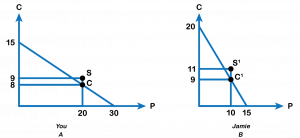2.6 Gains from Trade
Trade Example
Suppose, before trade you choose to produce 20 pineapples and 8 crabs and Jamie chooses to produce 10 pineapples and 9 crabs. Because you have a comparative advantage in growing pineapples, you should specialize in pineapples and can grow a maximum of 30 pineapples. Jamie specializes in crabs and produces a maximum of 20 crabs. In this situation, both players are producing only the goods they have the comparative advantage in.
Before Trade Production Possibilities:
| Pineapple | Crab | |
|---|---|---|
| You | 20 | 8 |
| Jamie | 10 | 9 |
Exchange: If You and Jamie choose to trade 10 pineapples for 9 crabs, then after trade You are left with 20 pineapples and 9 crabs (point S in Fig 2.8 Panel (A)) while Jamie is left with 10 pineapples and 11 crabs (Point S1 in Fig 2.8 Panel (B)). Therefore, after the trade, You gain +1 crab, and Jamie gains +2 crabs. Both trading partners move to a point outside their current PPF, resulting in economic growth. Figure 2.8 (Panels (A) and (B)) and Fig 2.9 below show Yours and Jamie’s production possibilities both before and after the trade. After trade, you move to S from C, while Jamie moves to S1 from C1.

| You | Jamie | |||
|---|---|---|---|---|
| Pineapples | Crabs | Pineapples | Crabs | |
| Before trade production | 20 | 8 | 10 | 9 |
| Specialization | 30 | 0 | 0 | 20 |
| After trade production and consumption | 20 | 9 | 10 | 11 |
| Gains from trade | - | +1 | - | +2 |
Fig 2.9
The implications of our model for trade are that
(a) trade is mutually beneficial
(b) certainly redistributes resources among the two trading partners
(c) leads to specialization and greater skills.
This reallocation of resources produces enormous benefits, but they do not come without costs.
In Chapter 2, we have explored the production possibility model in-depth, looking at a simplified version of trade and deepening our understanding of opportunity costs. Now, we can take our knowledge of basic economic modelling and examine one of the most important of microeconomics: supply and demand.
Attribution
"2.3 Trade" in Principles of Microeconomics by Dr. Emma Hutchinson, University of Victoria is licensed under a Creative Commons Attribution 4.0 International License, except where otherwise noted.

